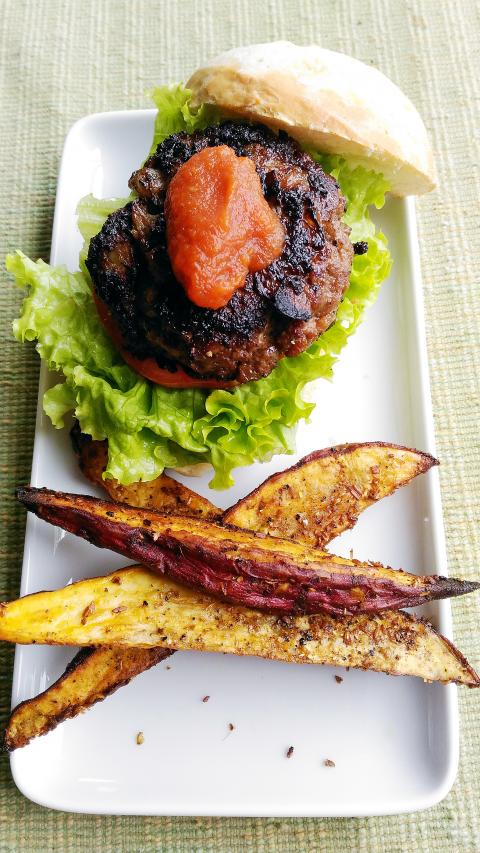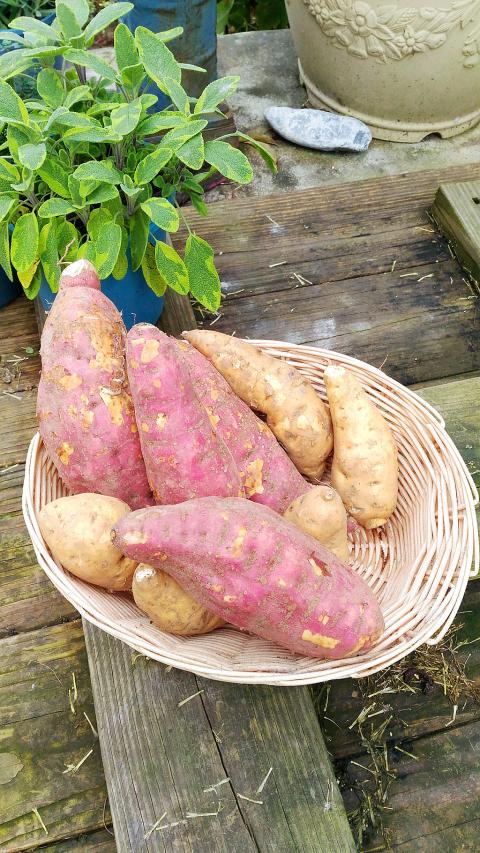Sweet potato is available all the year round in Taiwan, but is at its best between March and November, and so now that the coldest of the winter weather is over, the new year’s crop is gradually beginning to make an appearance in the markets. It is the quintessential Taiwanese food, its deep roots in local culture accentuated by the fact that the slightly elongated tubers can easily bare a resemblance to the main island of Taiwan, a fact that has not failed to inspire marketing executives around the country.
It must be said that the link between Taiwan and the sweet potato is not altogether a happy one. Toward the end of the 16th century, the Spanish introduced the sweet potato to the Philippines. Its transmission to China is generally associated with a famine in Fujian Province in 1593, when the governor sent out an expedition to search for suitable food plants. It returned from the Philippines with the sweet potato, which quickly established itself in the local cuisine. The plant, or at least familiarity with its use, will probably have come to Taiwan through the many immigrants to the island from Fujian. Although often highly praised as a source of nutrition and even culinary delight, the sweet potato in Taiwan has never fully escaped its associations with poverty and famine, with many popular local proverbs maligning it as a food of last resort.
As with many local vegetables, it is now making something of a comeback, as this robust tuber can often do without extensive chemical fertilization and protection to survive, and is therefore much favored by organic farmers. Its association with a resurgent Taiwanese identity has also worked in its favor.

Photo by Ian Bartholomew
The sweet potato is sometimes called “yam,” though this is incorrect, as yams belong to quite another family, and to confuse matters further, neither are they related to the potato, though these are both tubers and both probably originated in the Americas. It was probably first tasted by Europeans traveling with Columbus, and it was the Spanish and Portuguese who paved the way to its becoming a major food source in Asia.
Sweet potato comes in a wide variety of types, ranging from tubers with a beige flesh to those with a bright, almost luminescent orange, with purple and yellow thrown in for good measure. The darker fleshed tubers have a higher concentration of beta-carotene, but tend to be softer, breaking up more easily during cooking than the paler varieties. Different types of sweet potato lend themselves to distinctly different uses.
One of the most basic preparations and a fond childhood memory for many Taiwanese is of sweet potato cooked in rice porridge, a combination that provided both ballast and nutrition for the farmers of yesteryear. Generally yellow-fleshed sweet potato is used, and when prepared in this way, the dish is tolerable; I have tasted it on occasion when orange fleshed tubers have been used, but these easily become mushy and the sweetness taints the porridge, taking it beyond the pale.

Photo by Ian Bartholomew
Sweet potato is often used as a puree, either in sweets or savory, but I have never found either of these terribly attractive. Attempts at everything from sweet potato pie, that icon of traditional African-American cooking, to North African tagines with sweet potato and dates all seem to allow the starchiness and sweetness of the tuber to get out of hand. Sweet stodge or spicy stodge, or even sweet and spicy stodge, just don’t cut it, and while making an outstanding potato mash can be tricky at times, the task often seems impossible with sweet potato.
My favorite method of cooking sweet potato is roasting, which seems to keep the starch, or at least the perception of it, within acceptable limits. Sweet potato with bright orange flesh are a favorite in Taiwan, and one of the best ways of consuming this is baked whole in the skin. These are often available from street-side vendors using ovens adapted from old oil drums. They appear most often in the winter months, though they are less numerous now than they used to be. When baked, the skin peels off easily, and the fluffy, piping hot sweet flesh can be consumed in a sticky mess guaranteed to burn fingers and ruin gloves. This dish can be easily prepared at home if you have an oven; just remember to prick the skin with a skewer to avoid the whole tuber bursting open.
Roasting yellow or beige-colored sweet potato makes a lovely addition to a mix of roast vegetables, or, as in the recipe below, to be served as baked chips with a burger or other snack.
Given the wide variety of sweet potatoes, each with their own different nutritional profile, it is probably sufficient to say that they are packed with important vitamins and minerals that differ radically from the common potato. It is worth noting that although a sweet and starchy tuber, studies have shown that the sweet potato has a low to medium glycemic index and is actually beneficial for regulating blood sugar (see: www.cals.ncsu.edu/agcomm/magazine/winter07/diabetes.html).
Recipe for beef burger with sweet potato chips
(Serves 4)
Oven baked chips, while not having the same crispness of those coming out of the deep fryer, are significantly more healthy and work particularly well for sweet potato, giving time for their interior to be cooked through to a tender fluffiness. Studies have shown that a small amount of oil used during cooking of sweet potatoes actually increases the body’s uptake of beta-carotene, so I take this as an excuse to have a free hand with the extra virgin olive oil. The burger patty in this recipe panders shamelessly to my love of fried onions, and its simplicity rewards the use of good quality meat.
Ingredients
For the chips
5 medium-sized sweet potatoes
2 tbsp coriander
1 tbsp cumin
1 tsp paprika
1 tsp salt
1 tsp black pepper
2 tbsp olive oil
For the burger
500g beef mince
1 large onion
Salt and pepper
4 hamburger buns
Additions
Tomato
Lettuce
Ketchup
Method
For the chips
1. Preheat oven to 200c.
2. Wash the sweet potato thoroughly, using a brush to dislodge dirt in the creases. There is no need to peel the skin.
3. Cut into wedges and place on a baking sheet lined with foil.
4. Grind together the coriander seed, cumin and black pepper. Add salt and paprika and mix well.
5. Toss the sweet potato with the dry spices until well coated then drizzle with olive oil.
6. Place in the upper half of the oven for 40 minutes, tossing once or twice.
7. Adjust seasoning and serve.
For the burger
1. While the sweet potato chips are in the oven, finely chop an onion and saute over medium heat, stirring occasionally, until soft and caramelized. They should be soft enough to be virtually mashed into the meat.
2. Allow to cool. Mix with the beef and mold into patties.
3. Fry over medium heat until cooked through and crusty on the outside. Without egg or breadcrumbs to hold them together, these patties are quite delicate. The upside is there is little to get in between your taste buds and the flavor of minced cow.
Put it all together
1. Place the cooked patty in a bun with lettuce and tomato. Throw on a splash of ketchup and serve with sweet potato chips.
Ian Bartholomew runs Ian’s Table, a small guesthouse in Hualien. He has lived in Taiwan for many years writing about the food scene and has decided that until you look at farming, you know nothing about the food you eat. He can be contacted at Hualien202@gmail.com.

Aug. 4 to Aug. 10 When Coca-Cola finally pushed its way into Taiwan’s market in 1968, it allegedly vowed to wipe out its major domestic rival Hey Song within five years. But Hey Song, which began as a manual operation in a family cow shed in 1925, had proven its resilience, surviving numerous setbacks — including the loss of autonomy and nearly all its assets due to the Japanese colonial government’s wartime economic policy. By the 1960s, Hey Song had risen to the top of Taiwan’s beverage industry. This success was driven not only by president Chang Wen-chi’s

Last week, on the heels of the recall election that turned out so badly for Taiwan, came the news that US President Donald Trump had blocked the transit of President William Lai (賴清德) through the US on his way to Latin America. A few days later the international media reported that in June a scheduled visit by Minister of National Defense Wellington Koo (顧立雄) for high level meetings was canceled by the US after China’s President Xi Jinping (習近平) asked Trump to curb US engagement with Taiwan during a June phone call. The cancellation of Lai’s transit was a gaudy

From Godzilla’s fiery atomic breath to post-apocalyptic anime and harrowing depictions of radiation sickness, the influence of the nuclear bombings of Hiroshima and Nagasaki runs deep in Japanese popular culture. In the 80 years since the World War II attacks, stories of destruction and mutation have been fused with fears around natural disasters and, more recently, the Fukushima crisis. Classic manga and anime series Astro Boy is called “Mighty Atom” in Japanese, while city-leveling explosions loom large in other titles such as Akira, Neon Genesis Evangelion and Attack on Titan. “Living through tremendous pain” and overcoming trauma is a recurrent theme in Japan’s

As last month dawned, the Democratic Progressive Party (DPP) was in a good position. The recall campaigns had strong momentum, polling showed many Chinese Nationalist Party (KMT) lawmakers at risk of recall and even the KMT was bracing for losing seats while facing a tsunami of voter fraud investigations. Polling pointed to some of the recalls being a lock for victory. Though in most districts the majority was against recalling their lawmaker, among voters “definitely” planning to vote, there were double-digit margins in favor of recall in at least five districts, with three districts near or above 20 percent in